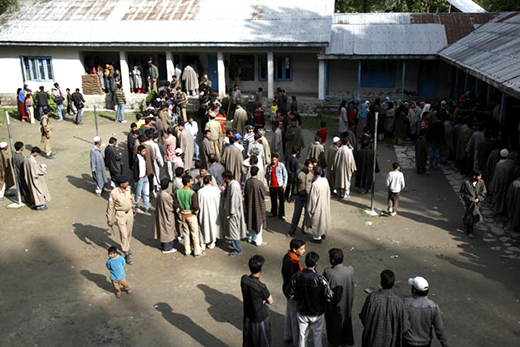by Masood Hussain
SRINAGAR: Kashmir’s handicraft basket will now have a Quick Response (QR) code alongside the GI labelling. This is part of the serious effort by the Jammu and Kashmir government to improve buyer confidence and adequately promote handmade works. The initiative aimed at fair trade practice is taking place at a time when the handicraft sector is exhibiting a strong revival with exports in the last nine months crossing Rs 729 crore, for the first time after 2019.
Now, 13 Kashmir crafts including six handicrafts already having GI will have distinct QR codes. These include Kashmir Pashmina, Kashmir Sozni, Kani Shawl, Kashmir Walnut Wood Carving, Kashmir Papier Machie and Khatamband. In the case of Kashmir Pashmina’s GI labelling has been redeveloped and has been integrated with the QR-Code certification module, Director Handicrafts and Handlooms, Mehmood Ahmad said.
Kashmir carpet already has a QR code along with the GI labelling. It was launched by Lt Governor Manoj Sinha on February 10, 2022.
The GI certification ensures the buyer that the product is produced only in a particular geographical location and no manufacturer other than those recognized by the registration may claim to produce or sell the same by the name specified under the registration. The QR code gives the buyer the facility to use his cell phone and locate the craftsman or the institution that made the product for further satisfaction of its genuineness.
Jammu and Kashmir started GI coverage for its craft basket in 2007. So far, it has GI certification available for seven crafts: Kashmir Pashmina, Kashmir Sozni, Kani Shawl, Papier Machie, Khatamband, Kashmir Walnut Wood Carving and Kashmir Hand-knotted Carpet.
For issuing the GI label for Kashmir Pashmina, Jammu and Kashmir government established Craft Development Institute (CDI) in 2013 where the Assistance to State for Infrastructure Development of Exports (ASIDE) assisted Pashmina Testing and Quality Certification Centre (PTQCC) tests the products for its genuineness. “So far, it has certified and labelled more than 16,000 genuine Kashmir Pashmina products and has also conducted 1900 Non-GI tests to ascertain the genuineness of various Non-GI handicraft products,” Ahmad said. “In 2022, the demand for labelling at the centre increased by 1100 per cent.”
Ahmad said it is helping the product in competing with rivals across the world. In the case of carpets, the dual certification – the GI label and user-friendly QR code have restored consumer confidence hugely. “Till February 2022, we have certified and labelled 6000 carpets,” Ahmad said.
The data of carpet export exhibits an upward trend. In the last nine months of fiscal 2022 ending December 31, Kashmir exported carpets worth Rs 212.23 crore. This is expected to mark a return from the sluggish exports that Kashmir carpet witnessed from 2017-18 when carpets worth Rs 452.12 crore were sold. The carpet exports were of the order of Rs 353.63 crore in 2018-19; Rs 395.78 crore in 2019-20; Rs 299.56 crore in 2020-21and Rs 251.06 crore in 2021-22. With three months more to go, 2022-23 may have a better export tally in carpets. Kashmir carpets are the major part of the handicrafts sale from the valley making slightly less than half of the overall turnover.
The handicrafts and handlooms department believes that the distinct QR-coding will help address the deficit that Kashmir crafts have inherited as it avoided implementing the new fair-trade practices. Interestingly the QR-coding is available for products which do not fall in the GI-certified basket.
“For the convenience of the artisans, traders and exporters, we have heat application secured fusion labels or fabric-based non-tearable, waterproof labels which can be stitched on the product based upon the liking of the customer,” Ahmad said. “The newly introduced QR-Code-based labels are secure tampered proof labels with invisible UV and Micro-Text, heatproof (25 F to 140 F) and shall work on all smooth and rough surfaces.”
The QR codes are available for genuine handmade crafts under the non-GI category like Copperware, Willow Wicker, Silverware, Filigree and some other items.
These interventions are taking place at a time when the Kashmir handicraft sector is witnessing an improved turnover as the exports are showing an upswing. The global markets are recession hit and Covid19 has been a key role in it.
Data suggest that in the first three quarters of the current fiscal ending December 31, 2022, the overall exports of Kashmir handicrafts were at Rs 728.99 crore. This is much improved in comparison to the overall exports of Rs 563.13 in 2021-22 and Rs 635.52 crore in 2020-21. The handicraft exports were at Rs 1090.12 crore in 2017-18 and Rs 917.93 in 20180-19. Kashmir remained under lock and key since 2019 summer, a situation that was extended by the Covid19 pandemic.
Now the government is working to add ten more crafts in the GI listing. The mandatory dossiers have already been submitted to the GI registry at Chennai. These crafts are Kashmir Namda, Wagguv, Shikara, Gabba, Kashmiri Willow Bats, Crewel, Chain Stitch, Tweed, Basohli Paintings and Chikri Wood. Some of these items have already access to QR-code labelling.















